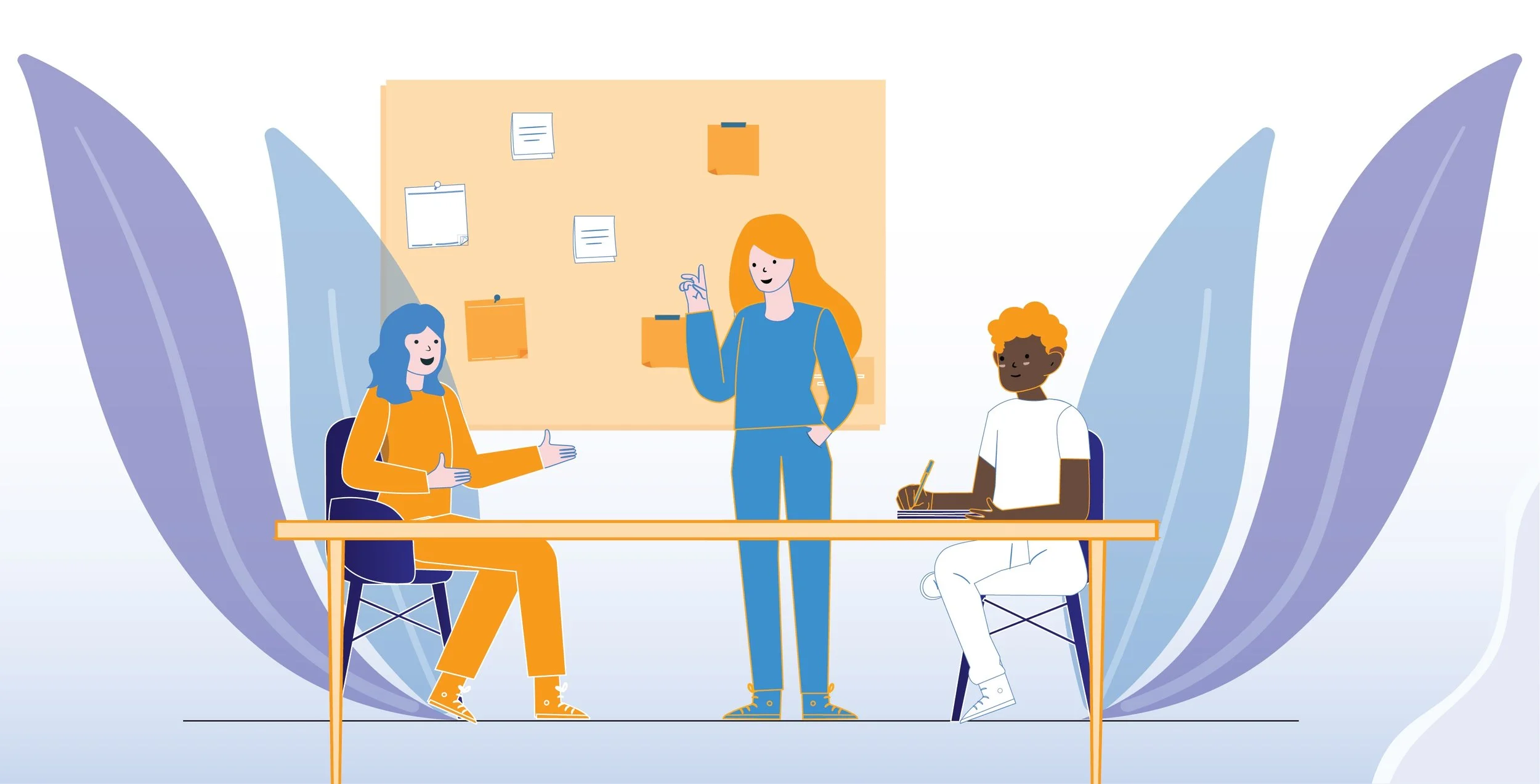Helping students give & receive feedback
This article is part of our series on how to help students develop their collaborative superpowers and maximise the effectiveness of working in teams across a PBL project. To learn more about how we teach collaboration, see here.
Collaboration is hard. If you’ve ever run a PBL unit with your class, you’ll know that team conflict is a key reason for the unit not working.
One of the hardest – yet most important – aspects of collaboration is being able to give and receive feedback constructively. Nobody likes being told something negative about themselves or something they’ve done. Students are no different.
But open and honest communication is a hallmark of every successful team. And if students can’t give and receive feedback dispassionately, its effects are corrosive:
A student reacts angrily or emotionally to being given constructive feedback. They feel offended and no longer want to work with the person who gave the feedback. Or they withdraw from the group and no longer actively participate
A student with good intentions fails to give feedback in a constructive way. It comes across as rude or as a personal attack. Their teammate is justifiably upset; this disrupts team harmony and may lead to irreparable conflict
A student who reacts negatively to reasonable feedback will discourage their teammates from giving them feedback again. This robs that student – and the team – of chances to improve
A student who has misgivings about the direction their team is heading – but who doesn’t have the skills to articulate their feedback – may instead choose to stay silent. The team’s performance might be worse as a result because feedback went unspoken
So how do you teach students to give and receive feedback? Just follow three steps:
Identify the type of feedback you’re giving
Use a feedback strategy to deliver it
Ensure the recipient has strategies to process the feedback
Identify the type of feedback you’re giving
Feedback should be delivered differently depending on the situation. In particular, the way feedback is given depends on whether the feedback is on someone’s work or ideas, or whether it is on someone’s behaviour or actions.
We’ll explore the ways feedback should be delivered differently in each instance below.
Use a feedback strategy to deliver it
We encourage students to script (or plan) their feedback. It helps them think through what they want to say and how they say it. It’s a crutch to fall back on.
Using feedback strategies also help. They ensure feedback is clear and balanced. They increase the likelihood that feedback is taken on board and actioned.
Feedback on work or ideas
Two stars and a wish
A giver of feedback must outline two things they like about the work or idea (the ‘two stars’). Then, frame a constructive criticism as a ‘wish’. Instead of saying that something is poor or incorrect, you can ‘wish’ that something was different.
“I would like to give you a star for the detail you’ve given on how climate change is causing sea levels to rise and another star for explaining what impact this has on island nations. I wish you had also explained whether this problem will get worse in the future.”
Compliment sandwich
Introduce praise for one aspect of the work or idea; follow it with a problem or something which can be improved; then end by reminding the person of what they have done well and reinforcing their ability to improve.
“I think you’ve explained the impact of climate change on sea levels really well. It’s clear and quite detailed, which is fantastic. It would be helpful if you also explained whether sea levels will rise further in the future so we know whether the problem will get worse. I think that would make this even stronger. On the whole though, it is really well done!”
Warm and cool feedback
This encourages the giver of feedback to avoid extremes in both their praise and their criticisms. ‘Warm’ sentence stems include phrases like ‘Something I liked was…’ or ‘This worked for me because…’. Cool sentence stems include phrases like ‘One question I have is…’ or ‘Next time you could…’. In both cases, the feedback is tempered. It is neither too harsh nor too hyperbolic in its praise.
Feedback on behaviour or actions
When giving feedback on someone’s behaviour, students should be careful to avoid fundamental attribution bias. That’s a term used in cognitive psychology to describe the way we blame someone’s actions on an innate failing or weakness, but don’t apply the same logic to ourselves.
For example, if someone is running late to a meeting we’ve organised, we might ascribe it to a personality flaw they possess. They’re disorganised, selfish, or absent-minded. But if the roles were reversed and we were running late, we wouldn’t think of ourselves as those things. We’d instead blame it on the situation – the traffic, an unexpected phone call – rather than on our inherent weaknesses.
Students fall into this trap all the time. They might perceive a teammate to be rude, uncooperative, lazy, stupid, or any other negative attribute. But if they stopped and thought about why their teammate acted the way they did – or thought about what might prompt themselves to do the same thing – they might be more forgiving.
Overcoming this bias is crucial when giving feedback on another’s behaviour or actions. That’s because this feedback is most effective when it separates the action and the person.
Observations, feelings, needs, requests
This is a structured way of giving feedback on behaviour without criticising or blaming. It’s broken into four stages:
Observation – explain what you have seen or witnessed which you don’t like or agree with
Feelings – explain how what you observed made you feel. Do not include an outward interpretation of what the other person might be thinking. Focus only on what you feel
Needs - explain what you/the team need and why the behaviour caused you to feel a certain way
Requests – request (but don’t demand) that a change be made, or a different action be taken
“I noticed that when I was explaining my idea you were laughing at it and rolling your eyes (observation). That made me feel like I’m stupid and can’t think of good ideas (feelings). I need to feel supported and that I’m a valued member of the team (needs), so perhaps next time you think one of my ideas can be improved I’d really appreciate it if you can help me make it stronger (requests).”
STAR model
The STAR model stands for Situation, Task, Action, & Result. It keeps feedback focused what happened and why that behaviour produced an undesirable result, rather than getting caught up in blame and generalisations (or fundamental attribution bias).
Situation – describe the context (who, what, when, where)
Task – what is expected/the required standard in relation to the actions or behaviour?
Action - How did what happened fall short of those expectations?
Result - What was the negative outcome or impact of the action? Focus on the team
“When James was explaining his solution ideas, I saw that you were laughing at his and rolling your eyes (situation). It’s one of our team expectations that we listen respectfully to each other’s ideas (task), but the way you reacted meant James got upset (action). Now he doesn’t want to discuss his ideas with the team again. That’s going to harm us as he has a lot of good ideas to contribute (result).”
Ensure the recipient has strategies to process the feedback
Learning how to give feedback increases the chances that the recipient will internalise it. But unless students are also taught how to receive feedback, there’s every chance they’ll react badly to it – even if it’s delivered constructively.
To increase a student’s likelihood of using feedback to improve, there are three key stages they must be familiar with:
React to the feedback. An emotional response creates anger and resentment. It prevents the feedback from being internalised and reduces the likelihood of feedback being provided again. At this stage, students must practice managing their emotions, remaining calm, and listening to the giver of the feedback with an open mind
Reflect on the feedback. Students should ensure they’ve understood the feedback. Then, they can reflect on it in their time. They should ask themselves questions like:
What feedback have I received?
Do I understand why I was given this feedback?
What parts of the feedback do I understand or agree with? Why?
Is there anything I don’t understand or disagree with?
Do I need to clarify anything about the feedback?
Respond to the feedback. Not all feedback needs to be actioned. But if students agree with some of it, they should resolve how to implement it. They should also communicate to their teammates what they’re doing with the feedback and how they’ll try to improve. This encourages further feedback and creates a team culture where people are comfortable being vulnerable with each other
You’ll find practical, hands-on exercises to teach students how to give and receive feedback amongst Cura’s Collaboration Toolkit.
If you are passionate about enhancing students’ collaborative skills, get in touch with us at hello@curaeducation.com.


